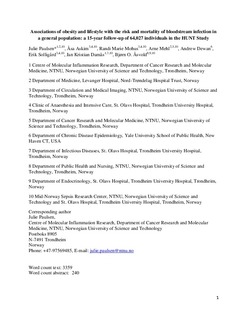Associations of obesity and lifestyle with the risk and mortality of bloodstream infection in a general population: a 15-year follow-up of 64 027 individuals in the HUNT Study
Paulsen, Julie; Askim, Åsa Susanne; Mohus, Randi Marie; Mehl, Arne; Dewan, Andrew; Solligård, Erik; Damås, Jan Kristian; Åsvold, Bjørn Olav
Original version
10.1093/ije/dyx091Abstract
Background: Bloodstream infections (BSI) cause considerable morbidity and mortality, and primary prevention should be a priority. Lifestyle factors are of particular interest since they represent a modifiable target.
Methods: We conducted a prospective cohort study among participants in the population-based Norwegian HUNT2 Survey, where 64 027 participants were followed from 1995–97 through 2011 by linkage to prospectively recorded information on BSI at local and regional hospitals. The exposures were: baseline body mass index (BMI) measurements; and self-reported smoking habits, leisure time physical activity and alcohol intake. The outcomes were hazard ratios (HR) of BSI and BSI mortality.
Results: During 810 453 person-years and median follow-up of 14.8 years, 1844 (2.9%) participants experienced at least one BSI and 396 (0.62%) died from BSI. Compared with normal weight participants (BMI 18.5–24.9 kg/m2), the age- and sex-adjusted risk of a first-time BSI was 31% [95% confidence interval (CI) 14–51%] higher at BMI 30.0–34.9 kg/m2, 87% (95% CI 50–135%) higher at BMI 35.0–39.9 kg/m2 and 210% (95% CI 117–341%) higher at BMI ≥ 40.0 kg/m2. The risk of BSI mortality was similarly increased. Compared with never-smokers, current smokers had 51% (95% CI 34–70%) and 75% (95% CI 34–129%) higher risks of BSI and BSI mortality, respectively. Physically inactive participants had 71% (95% CI 42–107%) and 108% (95% CI 37–216%) higher risks of BSI and BSI mortality, respectively, compared with the most physically active.
